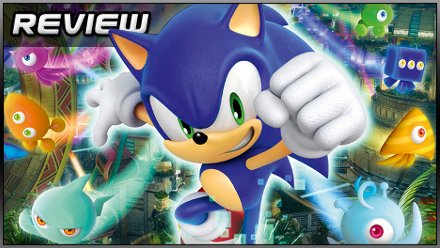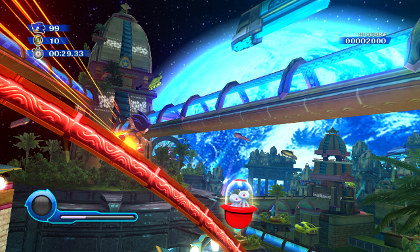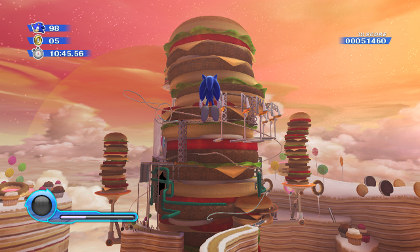
There’s an ongoing misconception when it comes to pinpointing exactly what makes a Sonic game great. Some mistakenly say it’s his defining character trait – the spinney rodent’s complete abuse of the laws of nature and physics as he shatters land-speed records. Countless pretenders from Zool to Bubsy the Bobcat prove that speed can be more of a hindrance than a help when mishandled.
No, the essential ingredient that defines a great Sonic game was none other than that brilliant Newtonian formula of mass meeting velocity – momentum. That continuous high of perpetual motion as the blue blur slices his way through the plains, loops and tunnels of the Green Hill Zone, leaving a wake of nuts, bolts and golden ring sparkles, is what exhilarated players in the mid-nineties. Momentum is a formula Sega defined with 16-bit Sonic, perfected with Nights Into Dreams on the Saturn and have ultimately failed to appreciate with almost every step those red sneakers have taken in the third dimension. Until now.

The controls don't utilise the Wii's abilities at all, begging the question; where's our HD version?
Ending a string of broken promises, failed experiments and bewildering design choices, Sonic Team have delivered the seemingly impossible – an extremely good Sonic game. First impressions don’t instil huge amounts of confidence as a whiny pop-punk intro theme clashes against grandiose orchestral world map music in what looks to be an uncomfortable leap from his fashionably edgy past to a more Mario Galaxy-like present. Of course this isn’t the first time Sonic has left Earth’s atmosphere, but the minimal trim of the hub world and linear level progression combined with planet exploration in deep space certainly show that Sonic has been paying attention to his old rival’s success.
The game’s six areas each house six acts that form the healthiest mix of high-speed in-to-the-screen 3D action stages and classic side-on platforming seen so far. In clear response to the positive feedback gained garnered from Sonic Unleashed’s daytime stages, the pleasingly tight 2D stages make up at least two thirds of your time controlling Sonic, with the remaining third’s 3D areas seeing more than their fair share of improvements too. Sonic’s high-speed antics still make following lengthy strings of rings with any degree of precision difficult with a Z-axis, but the system of switching between three planes action when the pace really ratchets up helps to keep control in the hands of the player.
Across both sets of stages exploration is kept to a minimum, focusing instead on that ever-important forward propulsion. That’s not to say that the levels are overly linear – as with Sonic’s sprite-based titles, there’s a clear distinction between beginner and pro routes through the stages, with skilled players navigating the high-grounds to accrue valuable point bonuses for extravagant grinds, as well as uncovering the five red stars hidden away in each course.
Level designs perfectly facilitate Sonic’s minimal, yet effective move set. Armed with a forward-thrusting boost and a downward-directed dive, well-played acts are choreographed ballets, discouraging deceleration as you cut your path from spring to boost pad. Thematically Sonic Team has drastically improved following a rut of indistinct generic action environments in previous titles. From looping chocolate-covered donuts and boosting through rivers of popcorn on Sweet Mountain to the aquatic beauty of mechanised Japanese gardens in Aquarium Park, the levels are a constant pleasure to be a part of.






 Satoru Iwata Video Interview - the late Nintendo president spoke with Kikizo in 2004 as 'Nintendo Revolution' loomed.
Satoru Iwata Video Interview - the late Nintendo president spoke with Kikizo in 2004 as 'Nintendo Revolution' loomed. Kaz Hirai Video Interview - the first of Kikizo's interviews with the man who went on to become global head of Sony.
Kaz Hirai Video Interview - the first of Kikizo's interviews with the man who went on to become global head of Sony. Ed Fries Video Interview - one of Xbox's founders discusses an epic journey from Excel to Xbox.
Ed Fries Video Interview - one of Xbox's founders discusses an epic journey from Excel to Xbox. Yu Suzuki, the Kikizo Interview - we spend time with one of gaming's most revered creators.
Yu Suzuki, the Kikizo Interview - we spend time with one of gaming's most revered creators. Tetris - The Making of an Icon: Alexey Pajitnov and Henk Rogers reveal the fascinating story behind Tetris
Tetris - The Making of an Icon: Alexey Pajitnov and Henk Rogers reveal the fascinating story behind Tetris Rare founders, Chris and Tim Stamper - their only interview? Genuinely 'rare' sit down with founders of the legendary studio.
Rare founders, Chris and Tim Stamper - their only interview? Genuinely 'rare' sit down with founders of the legendary studio. The History of First-Person Shooters - a retrospective, from Maze War to Modern Warfare
The History of First-Person Shooters - a retrospective, from Maze War to Modern Warfare
i love sonic games.